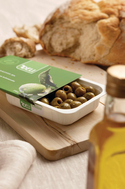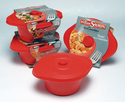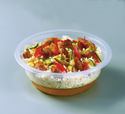Ready, steady?...
1 November 2012Are we seeing the first throes of a revolution in the way ready meals are packaged, leading to even stronger segmentation? Paul Gander talks to suppliers of plastics, board and metal packaging
In times of crisis and uncertainty, it seems, people reach for a ready meal. To take the example of UK chilled and frozen ready meals, value grew by 11.8% in 2010, 9.7% in 2011 and is estimated to clock up a further 10.7% growth in 2012, set to total just under £2,600 million, according to Mintel.
The market research company is quick to point out that much of this growth can in fact be accounted for by raw material price increases. Nonetheless, figures such as these show a category doing more than just surviving the downturn. With an alternative perspective on growth, supplier to the ready meals industry Faerch Plast UK says it has seen fairly steady 4% year-on-year growth in plastics packaging volumes that are destined for use in the category.
The UK market has its own idiosyncrasies, of course. Within its wider category of ‘prepared foods’, Mintel includes the significant sub-category of pies and pasties, as well as ready-to-cook meals. Figures for 2011 show chilled meals with a 55% share of category value, with frozen on 12%. Ready-to-cook products accounted for just 5%, with the final 28% coming from pies and pasties.
Stable sector
Again offering its own slant on the market, Faerch Plast estimates that frozen products account for around 30% of the overall UK ready meals market.
The figure, says Faerch Plast UK MD Joe Iannidinardo, has remained fairly stable over the years. Despite its expansion, the company’s core business continues to be in crystalline polyethylene terephthalate (CPET), the traditional pack of choice for dual-ovenable meals.
So it is hardly surprising that the view he takes of the market as a whole, and the packaging mix within it, is essentially one of ‘business as usual’.
There have been some changes, he concedes: “There isn’t quite as much promotional activity, which is partly to do with ingredient price increases and partly with the war on waste.” He is referring to the perception that ‘two-for-the-price-of-one’ offers, for example, have encouraged domestic food waste.
Nor does Faerch Plast believe that activity at the premium end of the ready meals spectrum – and particularly packaging innovation – is anything new. “Whether you’re talking about paperboard or aluminium, all these alternatives have been around for a long time,” says Iannidinardo. “What you tend to see is migration to other products and back again. I think it’s actually a very stable situation.”
To what extent is there a market for meals positioned as being ‘natural’ and organic, for example, using packaging as an additional differentiator? “You do see products of this type at the margins of the category,” he explains. “But mainstream products still tend to be in CPET.”
Board action
Like Faerch’s Iannidinardo, Proseal director Rob Hargreaves has seen fashions in ready meal packaging come and go – and sometimes come back again. There have been cases of ovenable board packs supplied to premium-end UK retailer Marks & Spencer, for instance, which “fizzled out because of unit cost”, he says.
But Hargreaves does see some indications that the balance may be about to swing more decisively in board’s direction. “Board’s presence has grown in the traysealing segment,” he confirms. “And folded board cartons are probably the most favoured option.”
From Proseal’s perspective, this has much to do with their work alongside packaging designer Rapid Action Packaging (RAP) on hermetically sealed sandwich packs.
“We pioneered the RAP system, and have machines installed at Daunat in France hermetically sealing and gas flushing sandwich packs,” says Hargreaves.
“Now, we’re working with RAP on a tray version of the same system.”
He adds: “We’re also working with a Dutch company on a radical idea for board trays that can be hermetically sealed.” For now though, there is not much more he can say about the technology.
From the US, board supplier and packaging firm Meadwestvaco (MWV) reports recent moves towards fibre-based alternatives in the ready meals category. A few months ago, the Trader Joe’s grocery chain launched a frozen ready meal line in trays made from MWV’s MWare paperboard.
“The whole image of the range, which is actually packed in France, is to do with a premium positioning,” says director of cookware packaging solutions Chris Brady.
But the pack that MWV is currently most excited about is its SmartFare pressed paperboard tray. With a polyester coating, the pack can be gas flushed and hermetically sealed, and is dual-ovenable. Currently, the company is targeting the UK chilled ready meals market.
“We’ve ensured it is a drop-in solution for food manufacturers, since it fits into Mondini or Proseal sealing head tools,” says Brady.
The company has carried out research with London-based consumers, running parallel tests with CPET and SmartFare. Consumers complained about the way that CPET softened and became too hot to handle, he says, problems which did not arise with the board pack.
“We’re talking to all the major food processors and trying to get them excited about the fact that they can get a brand presence and message on the tray itself,” Brady asserts.
As well as premium lines, board packaging suppliers believe that organic ranges and those with healthier positionings could benefit from such radically different packaging. In fact, according to Mintel, while value, kids’ and organic ranges in UK ready meals showed negative value growth over the period between 2009 and 2011, the healthy segment grew by a vigorous 55%. Standard ranges grew by over 20% and premium lines by just under 3%.
Healthy competition
There are other ways of segmenting the market and adding value. Interestingly, when Alexir Partnership won a Starpack Excellence award in the UK earlier this year for its Batchelor’s Deli Box noodle pack, the brand-owner said it hoped the new board-based format would attract more women to the pot snacks category.
These outlying regions of the prepared foods category are seeing more board innovation in general. Earlier this year, UK retailer Tesco began using Intelligent Packaging Solutions’ Desto cup for its Piing Pasta Pots. This is actually a hybrid pack, combining a paperboard cup with a separable polypropylene (PP) insert to create a microwaveable pot. The use of the plastics also allows the inclusion of a window for product visibility, and the two parts can be separated easily for recycling.
When it comes to dual-ovenable options, competition in the board sector is no doubt helping to sustain the pace of innovation, and possibly to restrain pricing. In the UK, for instance, supplier of foil and board trays Nicholl Food Packaging is among those offering Stora Enso’s Delight dual-ovenable ready meal tray. “It can be optionally supplied suitable for MAP applications,” says head of sales Paul Ogiliev. “It can be automatically film lidded, with the same shelflife as CPET for fresh applications.”
With board rather than film lidding, Proseal has specific concerns. “We prefer it if a board tray has a hinged lid,” Hargreaves says. “You can run it down a CPET line, but if the board lidding is separate and not balanced, it can easily fall off.”
Speed not of the essence
Despite all this activity, packaging analyst at Mintel Benjamin Punchard believes that the biggest shift in recent times has not been in pack materials, but in pack sizes. “Over the past year, single-serve sizes have shown strong performance in new launches,” he says, putting this trend down to changes in the composition or dynamic of households.
There has also been a gradual move away from speed and ‘ready in 3 minutes’ type claims, says Punchard. In many cases, the focus is instead more to do with health or quality. “Healthy ready meals have leveraged steam packaging as part of this positioning, with steam pouches and trays with valves among the formats benefiting,” Punchard says.
Hand-in-hand with the emphasis on health and quality have come more ‘hand cooked’ or ‘home cooked’ positionings. “A good example of this is the use of plastics trays and lids that replicate casserole pots,” says Punchard, underlining the associations with care and quality.
Resisting the challenge
Meanwhile, smoothwall aluminium has really come into its own in the ready-to-cook segment. But as the figures show, this remains a relatively small market. Even where there is consumer resistance, some still argue for a role for aluminium in the dual-ovenable ready meals segment.
Nicholl emphasises the fact that its smoothwall range, like other foil packs, can be heated in “modern microwave ovens”. Ogiliev says: “Market perceptions vary from country to country. For example, in the US, smoothwall foil trays are on-shelf in a number of supermarkets with microwave cooking instructions.”
But if the metal packaging sector is targeting new markets, neither have the plastics converters been sitting back on their laurels. Faerch Plast says it has seen greater interest in microwave-only clear PP for more premium-positioned ready meals, which might boast a more interesting or colourful composition.
At the same time, plastics are biting at aluminium’s heels in the ready-to-cook segment. Faerch Plast has launched its Silver range of CPET trays, which potentially provides a metallic sheen for its entire range.
“Getting metallic shades with CPET is very difficult,” Iannidinardo admits. “After crystallisation, you can end up with just a dull grey, but we’ve managed to retain at least some of the metallic quality in these new packs.” He adds: “I would imagine this range will be used for extensions to existing ready-to-cook ranges.”
All in all, dual-ovenable plastics are demonstrating a resilience in and beyond their established markets that will make them difficult to dislodge, however strong a challenge is thrown down by the alternatives – from flexibles to board.
As Punchard at Mintel puts it: “With its good functionality, the traditional CPET tray is unlikely to be replaced as the core pack type for ready meals any time soon.”
Nicholl's Smoothwall aluminium range Nicholl Stora Enso’s Delight board trays Stora Enso Casserole-style pot-and-lid packs (top, RPC) and bowl-shaped packs are very much in vogue RPC Nicholl is a major UK/Ireland distributor for Stora Enso's DeLight solution DeLight Ready meal trivet pack, Faerch Plast Trivet Ready meal packs from Faerch Plast Ready







